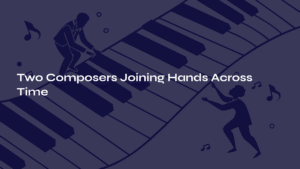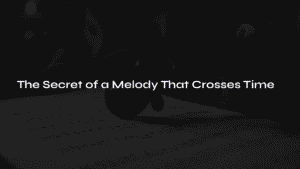Table of Contents

When Quiet Conversation Begins
Some music strikes the deepest corners of your heart from the very first note. Like an old friend suddenly dropping by to whisper, “Wait, would you listen to this story?” Mendelssohn’s Piano Trio No.1, 2nd movement is exactly that kind of music.
The moment the piano carefully unveils its opening melody, the air in the room transforms. Like someone lighting a candle, soft and warm light seeps in. And as the violin and cello join the conversation one by one, three voices begin to sing a song without words.

1839: A Genius’s Intimate Whisper
Felix Mendelssohn completed his Piano Trio No.1 in D minor, Op.49 in September 1839, when he was thirty years old. Having already demonstrated his magic of making the piano sing like a human voice through his Songs without Words series, he took a step further in this trio’s second movement. This time, it was a wordless chorus sung by three instruments together.
Robert Schumann’s praise of this work as “the Mozart of the 19th century” was well-deserved. Mendelssohn melted together Beethoven’s gravitas, Mozart’s elegance, and his own unique lyricism. Particularly this second movement is filled with the most pure and beautiful moments among his chamber works.
Though it was the Romantic era, Mendelssohn never let himself be swept away by emotion alone. The exquisite balance of placing Romantic sensibility gently upon Classical formal beauty is the charm of this work.

Musical Sketches Drawn by Three Instruments
The Piano’s First Confession
“Andante con moto tranquillo” – moving comfortably yet quietly. Even the performance marking is already poetic. Within the warm embrace of F major, the piano begins its opening measures. The melody drawn by the right hand feels like secretly eavesdropping on someone’s diary. Private, intimate, yet carrying universal emotions.
The left-hand accompaniment never interferes with the main melody. Like a good friend, it simply supports quietly from the side. During these eight measures, we encounter the essence of that “singing piano” that Mendelssohn showed in his Songs without Words series.
The String Instruments’ Response
When the piano finishes one phrase, violin and cello take the stage. The violin sings again the melody the piano just shared. But it’s not mere repetition. Like telling the same story in a different voice, it’s clothed with slightly different nuances and colors.
Meanwhile, the cello unfolds its own countermelody. Rather than adding harmony to the main melody, it tells a completely independent story. The three instruments converse in their respective voices, yet never overwhelm or interfere with each other. This is the essence of chamber music.
The Deep Breath of the Middle Section
As we reach the middle of the movement, the atmosphere shifts slightly. The cello begins to sing a deeper, more poignant melody. Like someone in conversation suddenly becoming serious and bringing out stories from deep within their heart. In this moment, the cello becomes not just an instrument but a personality.
The piano becomes even more careful at this point. While growing technically complex, the sound becomes softer instead. Playing the inner voices delicately while never losing the main melody – this is the most challenging part for pianists. But when this difficulty is sublimated into musical beauty, we encounter true art.

The Message of Songs Without Words
Listening to this movement, I often wonder: if this music had lyrics, what story would it tell? Probably a story about longing. Not regret for what’s lost, but happiness about holding something precious.
Like Mendelssohn’s Songs without Words, this second movement touches realms of emotion that words cannot express. From the opening melody the piano presents, we might recall warm afternoons of childhood, or think of quiet walks with loved ones. Because the music doesn’t present concrete images, we can freely paint our own inner landscapes.
Listening to the dialogue of three instruments, it seems like witnessing an ideal form of human relationships. Listening to each other’s words, bringing out one’s own story at appropriate moments, sometimes sharing silence together. If such conversation were possible between people – whether lovers, friends, or family – how beautiful would that be?

Small Guidance for Deeper Listening
First Listening Method: Following Each Instrument
When listening for the first time, focus only on the piano. Feel how that lyrical melody flows, where emotions intensify. The second time, follow the violin’s voice, and the third time, listen to the cello’s deep resonance. Finally, appreciate the overall picture created by all three instruments together.
Second Listening Method: Feeling the Flow of Time
This movement’s core is “con moto tranquillo” – moving yet quietly. Feel with your body that rhythm where the music neither stops nor hurries, flowing naturally. Like a peaceful river’s current.
Third Listening Method: Reading the Wordless Message
Though there are no lyrics, imagine the message the music wants to convey. Different stories will be heard according to each person’s experiences and emotions. That’s precisely the magic of Mendelssohn’s music.

Beauty That Transcends Time
Written nearly 200 years ago, this second movement still moves our hearts today. The reason is that Mendelssohn recorded universal human emotions and timeless beauty in musical notes.
This dialogue created by three instruments continues today. Even as performers change and eras pass, that essential beauty remains unchanged. Perhaps this is the power of true art – connecting hearts of past, present, and future across the boundaries of time.
Tonight, in a quiet moment, listen to this music. I’m deeply curious about what kind of story this wordless song Mendelssohn left behind will sound like to you.

Next Destination: Arensky’s Mourning and Reverence
If Mendelssohn’s lyrical dialogue has warmed your heart, how about experiencing a slightly different emotional spectrum? Let’s journey toward Anton Arensky’s Variations on a Theme by Tchaikovsky, Op.35a.
This work was born in 1894, one year after Tchaikovsky’s passing. This variation that Arensky wrote to honor his teacher and mentor Tchaikovsky goes beyond simple commemoration – it’s an expression of deep reverence that one artist pays to another.
Taking the simple melody “Legend” from Tchaikovsky’s Album for the Young as its theme, Arensky created a completely new universe through seven variations. If Mendelssohn’s intimate dialogue was like candlelight in a room, Arensky’s variations are like stained glass in a cathedral – majestic yet mystical.
Particularly the version arranged for string orchestra transcends individual instrumental dialogue, with the whole becoming one enormous voice that sings. Before this music where mourning and praise, longing and reverence intersect, we witness how art can transcend time and death.
If you’ve tasted personal lyricism in Mendelssohn’s Songs without Words, you’ll encounter emotion on a grander scale in Arensky’s variations.



